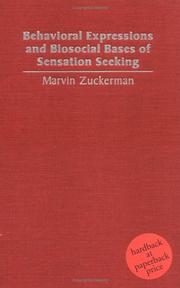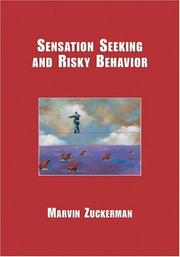| Listing 1 - 10 of 14 | << page >> |
Sort by
|
Book
Year: 1916 Publisher: New York : Macmillan Co.,
Abstract | Keywords | Export | Availability | Bookmark
 Loading...
Loading...Choose an application
- Reference Manager
- EndNote
- RefWorks (Direct export to RefWorks)
The aim of this volume is to present clearly the accepted facts of psychology. Throughout, emphasis has been placed upon fact rather than theory. Where theories conflict, the better one has been chosen, the others merely neglected. This may seem dogmatic in places, but in a text dogmatism is preferable to confusion. The point of view is on the whole functional; more attention is given to what mind does than to what it is. With this goes an emphasis upon the outward manifestations of consciousness and upon the behaviour of others to the subordination of the individual consciousness. Nevertheless, use is made of the results of structural psychology wherever they throw light upon function or are interesting for themselves. The position, it is hoped, combines the advantages of the rival schools. The content of a text-book in psychology is sufficiently agreed upon to require no comment. The general practice has been followed of introducing a brief exposition of the nervous system and its function. This is done with a full appreciation that it is no part of the task of the psychologist to teach neurology, but with the conviction that the beginning student in psychology is not likely to have acquired the knowledge elsewhere. In this treatment as little detail of structure has been given as is compatible with an understanding of function. Large use has been made of the hypothesis of the synapse. Its convenience in explaining habit and association outweighs any scruples about its final position in physiology. For the rest, I have deviated from traditional usage only in introducing rather more of the results of recent experiment. A body of knowledge has been developing in connection with memory and action that seems ripe for embodiment in a text. Similar considerations have led to the introduction of chapters on fatigue and on the transfer of training. The general arrangement followed is relatively novel. It consists in first developing a few simple principles and then making frequent application of them to the more complicated processes. Sensation, habit, retention, and selection or control are fundamental and appear repeatedly in mental operations of all kinds. When they are once understood, it is only necessary to develop their applications and interconnections to master the more developed operations. The method involves much repetition, but not more than the experience of the writer has proved necessary. What is not understood in one connection is made clear by the next application. (PsycINFO Database Record (c) 2016 APA, all rights reserved).
Book
ISBN: 0470268514 Year: 1979 Publisher: Hillsdale Erlbaum
Abstract | Keywords | Export | Availability | Bookmark
 Loading...
Loading...Choose an application
- Reference Manager
- EndNote
- RefWorks (Direct export to RefWorks)
Arousal (Physiology) --- Sensation seeking --- Arousal --- Testing --- Testing

ISBN: 0521437709 Year: 1994 Publisher: Cambridge Cambridge University Press
Abstract | Keywords | Export | Availability | Bookmark
 Loading...
Loading...Choose an application
- Reference Manager
- EndNote
- RefWorks (Direct export to RefWorks)
Affective and dynamic functions --- Sensation seeking --- Psychobiology --- Testing --- #PBIB:2002.3 --- Psychobiology. --- Sensation seeking. --- Testing. --- Stimulation seeking --- Personality --- Biological psychology --- Biopsychology --- Biology --- Human behavior --- Psychology --- Biological psychiatry

ISBN: 9783826023132 3826023137 Year: 2003 Publisher: Würzburg : Königshausen und Neumann,
Abstract | Keywords | Export | Availability | Bookmark
 Loading...
Loading...Choose an application
- Reference Manager
- EndNote
- RefWorks (Direct export to RefWorks)
Deutsch. --- Einbildungskraft. --- Imagination (Motiv). --- Literatur. --- Sensation seeking --- Sensation seeking. --- Stimulus intensity --- Stimulus intensity. --- Verbeeldingskracht. --- Geistesgeschichte 1680-1830. --- Geschichte 1680-1830. --- Bochum <2001>.
Book
ISBN: 1108675662 1108557252 1108738109 1108470866 1108687709 Year: 2019 Publisher: Cambridge : Cambridge University Press,
Abstract | Keywords | Export | Availability | Bookmark
 Loading...
Loading...Choose an application
- Reference Manager
- EndNote
- RefWorks (Direct export to RefWorks)
Most of us crave new experiences and sensations. Whether it's our attraction to that new burger place or the latest gadget, newness tugs at us. But what about those who can't seem to get enough? They jump out of planes, climb skyscrapers, and will eat anything (even poisonous pufferfish) ... Prompting others to ask 'what's wrong' with them. These are high sensation-seekers and they crave intense experiences, despite physical, or social risk. They don't have a death wish, but seemingly a need for an adrenaline rush, no matter what. Buzz! describes the world of the high sensation-seeking personality in a way that we can all understand. It explores the lifestyle, psychology, and neuroscience behind adrenaline junkies and daredevils. This tendency, or compulsion, has a role in our culture. But where is the line between healthy and unhealthy thrill-seeking? The minds of these adventurers are explained page by page.
Sensation seeking. --- Risk-taking (Psychology) --- Risk behavior --- Risky behavior --- Taking risks --- Human behavior --- Stimulation seeking --- Personality
Book

ISBN: 3828205763 3110508621 9783110508628 Year: 2016 Publisher: München Wien
Abstract | Keywords | Export | Availability | Bookmark
 Loading...
Loading...Choose an application
- Reference Manager
- EndNote
- RefWorks (Direct export to RefWorks)
Economics. --- Economic theory --- Political economy --- Social sciences --- Economic man --- Economics --- Risk-taking (Psychology) --- Sensation seeking --- Psychological aspects --- E-books --- Stimulation seeking --- Personality --- Risk behavior --- Risky behavior --- Taking risks --- Human behavior --- Behavioral economics --- Behavioural economics --- Crime. --- HIV. --- Social Learning Theory.

ISBN: 1591477387 Year: 2007 Publisher: [Place of publication not identified] American Psychological Association
Abstract | Keywords | Export | Availability | Bookmark
 Loading...
Loading...Choose an application
- Reference Manager
- EndNote
- RefWorks (Direct export to RefWorks)
Sensation seeking --- Risk-taking (Psychology) --- Arousal --- Risk-Taking --- Sensation --- Dangerous Behavior --- Psychophysiology --- Social Problems --- Behavior --- Nervous System Physiological Processes --- Behavior and Behavior Mechanisms --- Psychological Phenomena and Processes --- Nervous System Physiological Phenomena --- Sociology --- Musculoskeletal and Neural Physiological Phenomena --- Psychiatry and Psychology --- Social Sciences --- Phenomena and Processes --- Anthropology, Education, Sociology and Social Phenomena --- Psychology --- Social Sciences
Article
Year: 1997
Abstract | Keywords | Export | Availability | Bookmark
 Loading...
Loading...Choose an application
- Reference Manager
- EndNote
- RefWorks (Direct export to RefWorks)
Roman high- and low-avoidance (RHA/Verh and RLA/Verh) rats are selected and bred for extreme divergence in two-way active avoidance acquisition. In addition, compared to RLA/Verh rats, RHA/Verh rats are (behaviorally and physiologically) less anxious or reactive to stressors, show increased novelty (sensation)-seeking behavior as well as a higher preference for rewarding substances, and are usually less efficient in learning tasks not involving shock administration. The present article reviews evidence showing that neonatal handling and/or environmental enrichment leads to enduring effects (their magnitude frequently depending upon the rat line) on those behaviors. For example, it has been found that neonatal handling reduces most of the (behavioral and physiological) signs of emotionality/anxiety in RLA/Verh rats, while environmental enrichment increases their novelty seeking (also the case with RHA/Verh rats), saccharin and ethanol intake, and sensitivity to amphetamine. Finally, initial results (currently being further elaborated upon) support a preventive action of both environmental treatments on age-related impairments in learning a spatial, water maze task as well as on hippocampal neuronal atrophy
Acquisition. --- Age-related impairments. --- Amphetamine. --- Avoidance. --- Behavior. --- Central amygdala. --- Early stimulation. --- Elevated plus-maze. --- Emotionality. --- Enrichment. --- Environmental enrichment. --- Ethanol. --- Female rats. --- Handling. --- Hippocampal. --- Impairments. --- Increase. --- Increases. --- Learning. --- Locomotor-activity. --- Low-avoidance rats. --- Neonatal handling. --- Neonatal. --- Neuroendocrine traits. --- Neuronal. --- Novelty-seeking. --- Novelty. --- Perinatal flumazenil. --- Physiological. --- Preference. --- Protein-kinase-c. --- Rat. --- Rats. --- Review. --- Roman high-and low-avoidance rats,reactivity to stress,anxiety,novelty/reward seeking,neonatal handling,enriched environment,age-related deficit,spatial learning,hippocampus. --- Seeking. --- Sensation-seeking. --- Sensitivity. --- Shock. --- Sign. --- Spatial. --- Stressor. --- Stressors. --- Task. --- Tasks. --- Treatment.
Book
Year: 2021 Publisher: Basel, Switzerland MDPI - Multidisciplinary Digital Publishing Institute
Abstract | Keywords | Export | Availability | Bookmark
 Loading...
Loading...Choose an application
- Reference Manager
- EndNote
- RefWorks (Direct export to RefWorks)
Food is a source of nutrients but it also provides basic pleasure and aesthetic experiences. Acceptance, food choice, and consumption are affected by many factors, including both intrinsic and extrinsic factors and cues, as well as consumer characteristics. Food-elicited emotions are becoming a critical component in designing products that meet consumers’ needs and expectations. Several studies have reported on the presence of emotional responses to food and the relationships of these to product acceptability, preference, and choice. This Special Issue brings together a small range of studies with a diversity of approaches that provide good examples of the complex and multidisciplinary nature of this subject matter.
History of engineering & technology --- food values --- positive anticipated emotions --- attitude toward the brand --- attitude toward eating a hamburger --- purchase intention --- maize tortilla --- consumer behavior --- sensory profile --- texture --- physico-chemical parameters --- alcohol --- impulsivity --- emotional intelligence --- sensation seeking --- Italian consumers --- food attitudes --- psychological trait --- sociodemographic variables --- ethnic food --- consumer perception --- emotion --- purchase intent --- salads --- visual cues --- consumer behaviour --- wine attribute --- sherry wine --- gender --- food safety --- take-away food --- online public opinion --- emotional analysis --- topic analysis --- natural language processing --- food-evoked emotions --- sensory liking --- consumer acceptance --- food choice --- food intake and consumption
Book
Year: 2021 Publisher: Basel, Switzerland MDPI - Multidisciplinary Digital Publishing Institute
Abstract | Keywords | Export | Availability | Bookmark
 Loading...
Loading...Choose an application
- Reference Manager
- EndNote
- RefWorks (Direct export to RefWorks)
Food is a source of nutrients but it also provides basic pleasure and aesthetic experiences. Acceptance, food choice, and consumption are affected by many factors, including both intrinsic and extrinsic factors and cues, as well as consumer characteristics. Food-elicited emotions are becoming a critical component in designing products that meet consumers’ needs and expectations. Several studies have reported on the presence of emotional responses to food and the relationships of these to product acceptability, preference, and choice. This Special Issue brings together a small range of studies with a diversity of approaches that provide good examples of the complex and multidisciplinary nature of this subject matter.
food values --- positive anticipated emotions --- attitude toward the brand --- attitude toward eating a hamburger --- purchase intention --- maize tortilla --- consumer behavior --- sensory profile --- texture --- physico-chemical parameters --- alcohol --- impulsivity --- emotional intelligence --- sensation seeking --- Italian consumers --- food attitudes --- psychological trait --- sociodemographic variables --- ethnic food --- consumer perception --- emotion --- purchase intent --- salads --- visual cues --- consumer behaviour --- wine attribute --- sherry wine --- gender --- food safety --- take-away food --- online public opinion --- emotional analysis --- topic analysis --- natural language processing --- food-evoked emotions --- sensory liking --- consumer acceptance --- food choice --- food intake and consumption
| Listing 1 - 10 of 14 | << page >> |
Sort by
|

 Search
Search Feedback
Feedback About UniCat
About UniCat  Help
Help News
News